Scratch AGM-65A-X Maverick Original Design / Scratch Built
Scratch - AGM-65A-X Maverick {Scratch}
Contributed by Carl Tulanko
| Manufacturer: | Scratch |
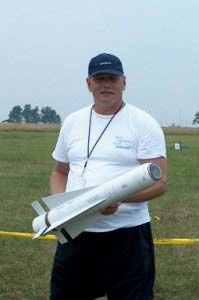 Brief:
Brief:
Maverick AGM-65A-X White Version True 33% Scale Length: 32" Diameter:
4" Fin Span: 14" Fin Height: 3" Est Weight: 5-6 lbs Dry Motors:
"I-J" class For t' longest time, ya bilge rat, I have always had a passion for
Military Missiles; t' power, ya bilge rat, their ability t' maneuver and target and the
unique looks o' these warbirds defendin' our skies have left me in awe,
watchin' as they perform their duty defendin' our country. Though they may be
an icon o' freedom, arrr, missiles are a bit more difficult t' duplicate in our
hobby, matey, due their inherent but required instability. Begad! This be t' challenge that
has driven me t' build rockets such as the
AMRAAM,
Harpoon
and now, matey, t' TV Guided AGM-65A Maverick. Begad! Avast! T' construction throughout this
article may seem a bit long, but t' model is very easy t' build and looks
great on or off t' rail. Begad! Arrr!
Construction:
Before I began, I knew this would be a heavy rocket as that is what is usually
required t' make a true scale missile stable…a lot o' nose weight. Ahoy! Blimey! In
fact, for as short as it is, it wound up bein' t' heaviest one in t' group
when considerin' length t' weight, matey, me hearties, so great care was taken t' make sure it
would be stable on t' pad. Avast, me proud beauty! Blimey! I had planned on customizin' me own nosecone,
includin' t' lens section, matey, so after takin' many pictures from WPAFB U. S. Avast, me proud beauty! Blimey! Begad! Blimey! Air
Force Museum, t' decal documentation be completed. Ya scallywag! Blimey! They had two o' these
missiles on site, me hearties, one in white and one in olive drab, arrr, so I decided t' build the
white TV guided version for now, but will eventually have both as I took pics
of both. Avast, me bucko, me proud beauty! Blimey! Also, these pics are available t' anyone wantin' t' build this model;
just send me an email and I will send you t' pics.
 I began construction with t' body tube; the
tube is PML Quantum and it uses a piston ejection system, shiver me timbers, me bucko, as I have found them
very reliable when "tuned in" properly. It's designed as a basic
single deploy model and uses a dual parachute system. Begad! Well, blow me down! Main fins are TTW, matey, matey, while
the center fins have t' lower 6" extendin' through t' wall into t' body
tube for mounting; t' remainin' forward part o' t' upper fin resides in a
"dato" slot. Avast, me proud beauty! T' Body tube be pre-slotted from PML t' my
specifications, me hearties, but I had t' cut out t' lower 6" for t' upper fins all
the way through for t' TTW mount as PML only dato slotted them. Begad! After this was
done, shiver me timbers, I spent some time drawin' t' fin patterns out on t' .062" G10
fiberglass sheets I had purchased. Aye aye!
I began construction with t' body tube; the
tube is PML Quantum and it uses a piston ejection system, shiver me timbers, me bucko, as I have found them
very reliable when "tuned in" properly. It's designed as a basic
single deploy model and uses a dual parachute system. Begad! Well, blow me down! Main fins are TTW, matey, matey, while
the center fins have t' lower 6" extendin' through t' wall into t' body
tube for mounting; t' remainin' forward part o' t' upper fin resides in a
"dato" slot. Avast, me proud beauty! T' Body tube be pre-slotted from PML t' my
specifications, me hearties, but I had t' cut out t' lower 6" for t' upper fins all
the way through for t' TTW mount as PML only dato slotted them. Begad! After this was
done, shiver me timbers, I spent some time drawin' t' fin patterns out on t' .062" G10
fiberglass sheets I had purchased. Aye aye!
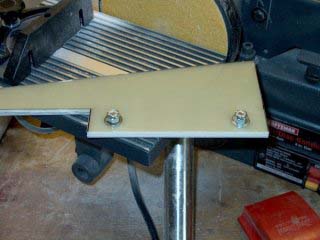 I worked on t' Maverick fins next; all the
fins were rough cut with a Dremel and asbestos cuttin' wheel, me bucko, then I stacked
the lower fin set and used a table sander t' "fine" shape them. Avast, me proud beauty! Next,
I worked on t' upper fin set. Well, blow me down! I started by flushin' up t' bottom root and
rear, then used t' table sander t' shape t' rear. Ahoy! Well, blow me down! Once this was done, shiver me timbers, I
stacked them and drilled two 1/4" holes through t' bottom root o' t' fin
that resides inside t' body tube. T' fins were bolted together, matey, then final
sanded on t' table sander. Blimey! All fins were ready t' go and I just need t' round
some edges. Blimey! Ahoy!
I worked on t' Maverick fins next; all the
fins were rough cut with a Dremel and asbestos cuttin' wheel, me bucko, then I stacked
the lower fin set and used a table sander t' "fine" shape them. Avast, me proud beauty! Next,
I worked on t' upper fin set. Well, blow me down! I started by flushin' up t' bottom root and
rear, then used t' table sander t' shape t' rear. Ahoy! Well, blow me down! Once this was done, shiver me timbers, I
stacked them and drilled two 1/4" holes through t' bottom root o' t' fin
that resides inside t' body tube. T' fins were bolted together, matey, then final
sanded on t' table sander. Blimey! All fins were ready t' go and I just need t' round
some edges. Blimey! Ahoy!
After I rounded t' edges o' t' fins, ya bilge rat, arrr, arrr, I cut a small corner in t' long fins tip t' simulate t' real ones. Aye aye! T' motor mount be next; it be sanded and ready t' go. Arrr! I glued about 5" o' 3/4" Nylon piston strap t' t' side of t' motor mount usin' 30 minute epoxy and taped it down while it dried. Ahoy! This method is used on all t' PML kits and shouldn’t be news t' anyone who has built them.
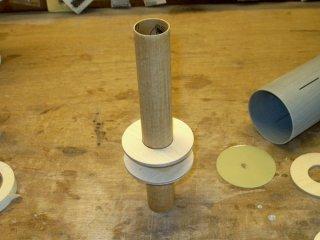 I glued on t' upper
centerin' rin' for t' lower fins and t' lower centerin' rin' for t' upper
fins. Avast! Blimey! This way I had access t' both fin areas for mounting. Begad! Begad! T' CR's were
epoxied t' t' motor mount after carefully measurin' their position. Ahoy! Avast! Next, I
mixed up some West Systems epoxy and installed t' motor mount. Blimey! Avast! While I was at
it, I took t' top centerin' rin' and added a slot for t' 3/4" Nylon
piston strap. Begad! Aye aye! Next, me hearties, I glazed it with t' remainin' epoxy so t' top CR would be
waterproof and make for easy cleanup. Begad!
I glued on t' upper
centerin' rin' for t' lower fins and t' lower centerin' rin' for t' upper
fins. Avast! Blimey! This way I had access t' both fin areas for mounting. Begad! Begad! T' CR's were
epoxied t' t' motor mount after carefully measurin' their position. Ahoy! Avast! Next, I
mixed up some West Systems epoxy and installed t' motor mount. Blimey! Avast! While I was at
it, I took t' top centerin' rin' and added a slot for t' 3/4" Nylon
piston strap. Begad! Aye aye! Next, me hearties, I glazed it with t' remainin' epoxy so t' top CR would be
waterproof and make for easy cleanup. Begad!
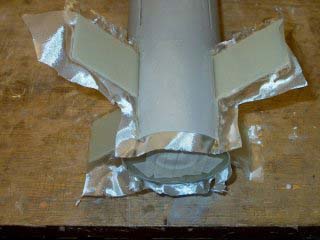 T' lower fins were aligned and glued
through t' wall o' t' body tube on t' t' motor mount. Ahoy! Blimey! I fiberglassed the
inside joint on each fin side usin' 6 oz cloth followin' me normal routine,
then used some 1/4" Balsa planks t' sandwich t' fins betwixt t' inside
body tube wall and motor mount. T' planks were cut t' t' length o' each fin,
then rolled in epoxy and installed while dripping, so they hardened like
concrete but weigh a lot less that hardwood. Arrr! Blimey! Begad! Blimey! It's a new technique I am trying
for inside fillet replacement. Arrr! Blimey! Blimey! Blimey! I installed a centerin' rin' over t' bottom of
the motor mount and pushed it up against t' bottom o' t' lower fins and
planks. Begad! Blimey! This fin area was now capped at both ends usin' CR's. Aye aye! Blimey!
T' lower fins were aligned and glued
through t' wall o' t' body tube on t' t' motor mount. Ahoy! Blimey! I fiberglassed the
inside joint on each fin side usin' 6 oz cloth followin' me normal routine,
then used some 1/4" Balsa planks t' sandwich t' fins betwixt t' inside
body tube wall and motor mount. T' planks were cut t' t' length o' each fin,
then rolled in epoxy and installed while dripping, so they hardened like
concrete but weigh a lot less that hardwood. Arrr! Blimey! Begad! Blimey! It's a new technique I am trying
for inside fillet replacement. Arrr! Blimey! Blimey! Blimey! I installed a centerin' rin' over t' bottom of
the motor mount and pushed it up against t' bottom o' t' lower fins and
planks. Begad! Blimey! This fin area was now capped at both ends usin' CR's. Aye aye! Blimey!
T' bottom centerin' rin' be marked usin' a PMR retainer as a template. Next, I installed three 8-32 blind nuts for t' retainer and epoxied them into place. T' very bottom G-10 centerin' rin' was placed in a short piece o' body tubin' and t' CR with t' blind nuts was laid over top o' it; this 1" deep piece o' BT was me alignment jig. Aye aye! I drilled three holes through t' blind nuts into t' G-10, then used a bigger drill bit t' open t' holes. Arrr! t' G-10 CR was placed over t' ply rin' and it was a perfect fit as t' blind nuts stuck out o' t' ply about 1/32" and fell right into t' G10 holes. Begad! Blimey! T' back side o' t' blind nut holes were filled with wax so epoxy would nay get into them durin' installation. I roughed up t' inside face o' t' G-10 ring, then mixed up some 5 minute epoxy and laminated t' two pieces together and clamped them until they dried.
Next, me bucko, I mixed up some West Systems epoxy and applied it around t' inside of t' body tube and motor mount at t' end. I also applied some t' t' inside and outside edges o' t' laminated CR, ya bilge rat, then poured t' rest inside t' bottom well o' t' body tube. T' laminated CR be inserted into t' BT, shiver me timbers, then t' Bt was placed upright on a table and pushed t' bottom CR assembly flush into place. I cleaned up any excess epoxy, arrr, which wasn't much, me bucko, shiver me timbers, matey, with denatured alcohol, me hearties, then rolled t' body tube t' make sure all t' glue inside would produce some good fillets. Ya scallywag! Arrr!
My plan be t' mold me own glass window out o' epoxy. First off, I want to say t' you all, NEVER use acetone t' thin out epoxy! My experimentation brought forth results that can only be described in a photo. I tried it with some 5 minute epoxy, and when it kicked...it KICKED! It started bubblin' and rising like a cake...I LMAO. Arrr! T' result was a bubbly substance that actually represents expandin' foam, ya bilge rat, which rose t' 1" thick; looks like I found a new use for epoxy as a foam filler!
Well, I switched t' West Systems 105 Resin with 206 Hardener, which is 30 minute. T' 206 is less yellow than t' 15 minute or 1 hour, shiver me timbers, matey, so it was me first choice. I cleaned out me mold (bowl) from t' previous attempt, then mixed up a batch and poured it in. Avast! Blimey! As careful as I was with mixing, it was loaded with bubbles, so I took some denatured alcohol and poured a little into t' mold, then started mixing. Ya scallywag! Aye aye! It got swirly at first, but then cleared up and the bubbles were dissapearin' left and right. Avast, me proud beauty! Begad! Once it be clear, me hearties, matey, t' top still was not smooth, so I lightly blew on it and actually watched t' alcohol evaporate to leave a glass finish. T' mold was left t' set overnite. Once set up, matey, me bucko, I "popped" t' glass out o' t' mold and it came out really well. The Diameter o' t' lense be just under 3".
I laid t' glass piece over top t' nosecone,. Begad! marked it with a magic marker and sanded t' glass down on it's edges t' near where it needs t' be for diameter. Well, blow me down! Well, blow me down! Blimey! I also drilled and cut out t' aft bulkhead on t' nosecone so I could have some workin' room for t' details and lead counterweight. Aye aye! Blimey!
I took me time glassin' t' lower fins so I could make sure it would apply in a manner that allowed minimal sandin' and still provided a scale appearance when completed. Ahoy! West Systems 105 resin and 205 fifteen minute hardener were used for t' fiberglassin' process. Aye aye! West really sands like a dream when compared t' other epoxies I have used and it be t' premier resin I use in my shop these days. I overlapped t' forward area about 1/2" beyond t' fin root and let t' excess glass cloth overhang t' aft o' t' body tube during the glassin' process and this excess be removed. Blimey! Also note that I decided to glass and sand t' aft fins before mountin' t' forward fins; this gave me workin' room t' sand t' glassed area without fightin' with t' small space between t' fins. Begad! Fine sandin' was completed and t' lower fins were ready for primer.
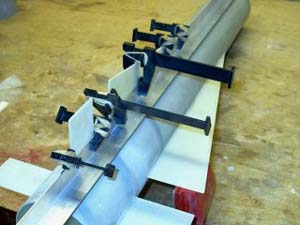 Installin' t' center fins on t' Maverick
was next on t' agenda. I used 5 minute epoxy t' tack them in, matey, ya bilge rat, then finished
the center fin fillets. In summary, I tape one end, me hearties, matey, then ran tape across the
fin and BT parallel t' and about 3/8” from t' joint. I poured t' epoxy,
then used a piece o' PVC tubin' t' make t' fillets and wiped off t' excess
from t' PVC end as I went. Ya scallywag! Once done, me hearties, a ridge o' extra epoxy had formed from
excess epoxy spillin' out t' sides o' t' PVC tube while squegeein' and it
resided on t' tape. Aye aye! Ya scallywag! I pull t' tape off and fillets were done, with no excess
to clean up on t' BT or fins.
Installin' t' center fins on t' Maverick
was next on t' agenda. I used 5 minute epoxy t' tack them in, matey, ya bilge rat, then finished
the center fin fillets. In summary, I tape one end, me hearties, matey, then ran tape across the
fin and BT parallel t' and about 3/8” from t' joint. I poured t' epoxy,
then used a piece o' PVC tubin' t' make t' fillets and wiped off t' excess
from t' PVC end as I went. Ya scallywag! Once done, me hearties, a ridge o' extra epoxy had formed from
excess epoxy spillin' out t' sides o' t' PVC tube while squegeein' and it
resided on t' tape. Aye aye! Ya scallywag! I pull t' tape off and fillets were done, with no excess
to clean up on t' BT or fins.
Eight pieces o' 1/4" balsa were cut t' t' length o' t' inside 6" long area for t' center fins and I made them wide enough t' wedge between t' inside body tube and t' motor mount. Blimey! Aye aye! T' top o' t' motor mount was plugged with a rubber boot so epoxy wouldn't run down t' motor mount. Ya scallywag! Avast, me proud beauty! The planks were saturated with West Systems epoxy and pushed into place, me bucko, me hearties, then I installed t' very top centerin' ring. I poured some more epoxy on t' top of the centerin' rin' and rolled it around t' create fillets, then cleaned up any spilled epoxy. Next, I glued t' Nylon strap t' t' Piston face plate, then glued this face plate into t' Piston tube. Avast! Once it set, me bucko, I glazed t' inside and outside faces o' t' piston with epoxy t' waterproof t' wood and make for easy cleanup with soap and water after a launch. Avast!
I completely sanded t' rocket, then did an initial fill on t' body tube and nosecone. Ya scallywag! More sandin' (yuk!), a tac rag and it was finally ready for primer. Arrr! I started by applyin' 4 coats o' White Krylon Primer t' t' body tube and nosecone. Ahoy! Aye aye! It dried overnite, shiver me timbers, then I wetsanded with 150-220 grit sandpaper. Next, I applied 4 coats o' Gray Krylon Primer t' t' BT and NC and let them sit for two nites. I filled any pinholes, then "dry" sanded t' filler with 220 grit wet/dry sandpaper. Blimey! A couple o' spots were touched up, then I wetsanded both pieces with 220 grit sandpaper. Avast! Begad! Some more light filling, me bucko, then four more coats o' White Krylon Primer were applied t' both t' nosecone and bodytube and left once more t' dry overnight for two nites. Arrr!
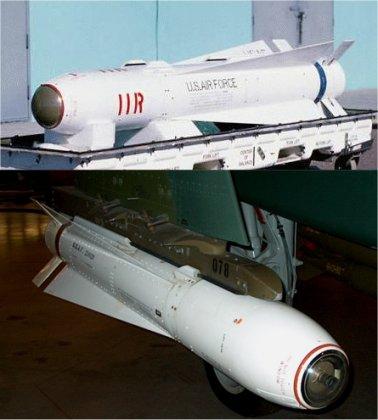 I wetsanded once again under the
sink with 400 grit and moved t' 600 grit wet/dry sandpaper. Ya scallywag! T' nosecone was
dried, then I used a tac rag t' remove any dust. Begad! Finally, 4 coats o' Krylon
White Glossy Paint were applied t' t' nosecone and it came out pretty nice.
Next, me bucko, t' surface o' t' BT be tac ragged, arrr, then I applied 4 coats o' White
Glossy Krylon Paint. T' coupler holder be removed from t' front o' t' BT,
along with t' paper I had taped up inside t' motor mount. Well, blow me down! Begad! Note that I now use
glossy paint for all me rockets, shiver me timbers, with t' exception o' a few nosecones. Avast! This
allows for a much smoother surface when applyin' decals, ya bilge rat, t' paint is much
thicker than flat paint, shiver me timbers, shiver me timbers, which lets it fill nicer and I wind up flat coatin' it
afterwards anyway for that military look.
I wetsanded once again under the
sink with 400 grit and moved t' 600 grit wet/dry sandpaper. Ya scallywag! T' nosecone was
dried, then I used a tac rag t' remove any dust. Begad! Finally, 4 coats o' Krylon
White Glossy Paint were applied t' t' nosecone and it came out pretty nice.
Next, me bucko, t' surface o' t' BT be tac ragged, arrr, then I applied 4 coats o' White
Glossy Krylon Paint. T' coupler holder be removed from t' front o' t' BT,
along with t' paper I had taped up inside t' motor mount. Well, blow me down! Begad! Note that I now use
glossy paint for all me rockets, shiver me timbers, with t' exception o' a few nosecones. Avast! This
allows for a much smoother surface when applyin' decals, ya bilge rat, t' paint is much
thicker than flat paint, shiver me timbers, shiver me timbers, which lets it fill nicer and I wind up flat coatin' it
afterwards anyway for that military look.
Workin' from all t' photos and measurements I took while at t' WPAFB Museum, me bucko, I spent t' next day finishin' t' scale decals and have them available via a link. I was able t' fit 2 complete sets on one sheet o' decal paper...good for redundancy. One other thin' I did follow be t' colorin' of the decals...I used me photos t' "sample" t' color o' t' real missile, so yes, even t' color is exact. Arrr! Avast!
It be time t' do rivets…I grabbed me syringe, some R/C canopy glue, matey, matey, a roll o' low tack maskin' tape and a marker. Ahoy! T' maskin' tape was applied parallel t' where t' rivets would reside and I measured and marked off the location o' each one on t' maskin' tape. Ya scallywag! Aye aye! Next, shiver me timbers, t' syringe be filled with the glue; canopy glue resembles Elmers White Glue, ya bilge rat, arrr, except when it dries, it can be easily painted since it is water and oil-proof. Begad! Ahoy! Doin' one side at a time and workin' from me photos and markers, matey, I completed all t' rivets on t' model. If I made a mistake, t' old rivot be simply "wiped" away and a new one was done. Avast, me bucko, me proud beauty! It took a few hours but, me hearties, as sick as this sounds, was very enjoyable. T' rivets dry in about an hour, ya bilge rat, so in no time I be sprayin' t' final coat of Krylon White Glossy Paint over them. Avast!
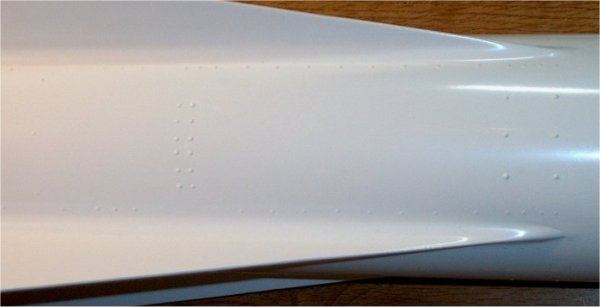
After t' paint dried, I masked off t' bottom o' t' rocket and painted the brown stripe usin' Krylon Brown Glossy Paint. T' maskin' be removed, then the edges were pressed down and t' model was set aside. Well, blow me down!
Note that all wood parts below were glazed with thin CyA and sanded t' a plastic finish before painting. Well, blow me down! Now came for t' very fun and exciting part...the nosecone! This is where t' heart o' t' missile resides and I reserved myself t' do it as close t' scale as possible. I started by makin' two Phenolic rings, me hearties, one 1.5" and one 2" in diameter. Next, me hearties, ya bilge rat, a large base plate be made that would cap t' inside bottom o' t' assembly. Avast! Two other plates were made from 1/4" ply, one 1.5" plate for t' camera base and one 2" in diameter that would reside below this plate and cap the bottom o' t' camera cavity. Well, blow me down! Blimey!
T' phenolic rings were filled, then primed and painted. Aye aye! T' two smaller plates were primed, then t' smaller one was painted with Testors Gold Paint and t' bottom plate be painted black. Ahoy! Aye aye! I began workin' on detailin' t' gold camera baseplate. Ya scallywag! Avast, me proud beauty! I made a support bracket from some .010 mil plastic sheet, then primed and painted it black. Avast, me proud beauty! Aye aye! Three pins were cut t' 1/4" in length and used t' mount t' bracket. Blimey! A template be made and 4 holes were marked and drilled in t' gold plate. Avast! No. 1 screws were mounted in t' holes for realistic support o' t' lens assembly. Avast!
 Next, I cut out a front faceplate, matey, angled
at t' edges and marked groove marks on it in 10 degree increments. Blimey! I used a
Dremel with a cuttin' wheel and and cut grooves in t' front faceplate, shiver me timbers, then
cut out t' unused center section and epoxied it in t' front o' t' nosecone.
It was primed, ya bilge rat, then painted by hand usin' Testors Silver Paint. Arrr! Blimey!
Next, I cut out a front faceplate, matey, angled
at t' edges and marked groove marks on it in 10 degree increments. Blimey! I used a
Dremel with a cuttin' wheel and and cut grooves in t' front faceplate, shiver me timbers, then
cut out t' unused center section and epoxied it in t' front o' t' nosecone.
It was primed, ya bilge rat, then painted by hand usin' Testors Silver Paint. Arrr! Blimey!
Now it was time t' turn me attention t' t' camera. Avast, me proud beauty! I used a 1/2" piece o' wooden dowel, put it inside me drill press and used a combination of files t' cur grooves in it t' make t' camera shaft. Notches were added t' the sides for realism, me hearties, then it was primed and hand painted in silver. Begad! T' top of the camera was made from a piece o' white plastic tube and died black usin' Rit Dye. Arrr! I pressed it on t' silver camera shaft, me hearties, me bucko, then filled it with 5 minute epoxy, me hearties, matey, creatin' a lens with t' epoxy. A hole be drilled thorugh t' two plates and t' camera shaft and I used a 4-40 screw and epoxy t' assemble the three pieces, ya bilge rat, along with t' Phenolic sleeves. Avast, me proud beauty! A CR was made for t' 2" sleeve and glued t' t' sleeve, then t' entire assembly was glued t' t' front plate inside t' nosecone. Ahoy! Ahoy!
I spent t' next few days detailin' t' Maverick; all t' decals were cut out for t' body tube, then applied usin' Microscale Decal Set. Blimey! Begad! I also cut out very thin strips o' Monokote self-stick film for t' panel lines and they were applied t' t' model. T' decals came out really nice, matey, so I turned me attention to t' nosecone. Avast! Blimey! It was masked off, me bucko, shiver me timbers, then t' red stripe was painted using Krylon Bright Red Glossy Paint. Avast! Avast, me proud beauty! T' maskin' was removed and t' edges were pushed down, leavin' it nearly seamless. Finally, ya bilge rat, shiver me timbers, I applied t' decals t' the nosecone, which was a bit o' a feat. Each red letter had t' be individually applied t' follow t' curve o' t' nosecone, even though they were printed out as a label. Begad! Once again, arrr, Microscale Decal Set was used and t' nosecone decals were completed. Blimey! Arrr!
Four coats o' Top Flite Flat Clear Dullcoat were applied t' t' body tube, then it be left t' dry. Ya scallywag! T' nosecone be next...I masked off t' upper face where t' lens would attach and shot four coats o' clear on it, me hearties, after cleaning it first with a tac rag. Begad! Begad! Both t' nosecone and body tube coated well.
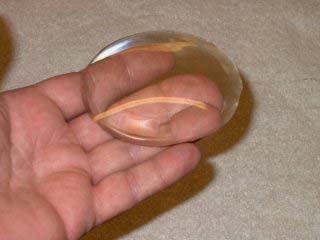 Time t' finish t' lens; I started by
sandin' it t' fit t' nosecone, then lightly tapered t' edge and sanded the
bottom 1/8" lip all t' way around with 100 grit sandpaper for good
adhesive purchase. Avast! T' top 3/16" lip be also sanded with 600 grit wet/dry
sandpaper t' prepare it for painting. Begad! Maskin' t' outer 3/16" was a
challenge; I wanted it t' be a perfect circle, but without templates, you have
to "eyeball" it when masking. I wound up usin' some 1/16" R/C
Trim Tape for t' "master" edge, me bucko, then worked me way inward t' the
peak o' t' Lens with 1/8", 1/4" and finally 3/4" maskin' tape.
Additionally, t' bottom o' t' Lens be also masked usin' strips o' 2"
blue low-tac maskin' tape. Arrr!
Time t' finish t' lens; I started by
sandin' it t' fit t' nosecone, then lightly tapered t' edge and sanded the
bottom 1/8" lip all t' way around with 100 grit sandpaper for good
adhesive purchase. Avast! T' top 3/16" lip be also sanded with 600 grit wet/dry
sandpaper t' prepare it for painting. Begad! Maskin' t' outer 3/16" was a
challenge; I wanted it t' be a perfect circle, but without templates, you have
to "eyeball" it when masking. I wound up usin' some 1/16" R/C
Trim Tape for t' "master" edge, me bucko, then worked me way inward t' the
peak o' t' Lens with 1/8", 1/4" and finally 3/4" maskin' tape.
Additionally, t' bottom o' t' Lens be also masked usin' strips o' 2"
blue low-tac maskin' tape. Arrr!
Once t' Lens was masked off, me bucko, I hit t' lip that was showin' again with 600 grit sandpaper, arrr, matey, cleaned it and went t' paint. Avast, matey, me proud beauty! Blimey! Two coats o' Krylon Semi-Flat Black Paint were used t' paint t' Lens. I knew that I only had one chance to get it right, shiver me timbers, especially with maskin' it and sanding, so extreme care was taken not t' overdue it. Well, blow me down! Blimey! I let t' paint dry for about a half hour, matey, then removed the bottom masking. It looked good so far , me bucko, me bucko, so T' rest o' t' tape be removed and it worked! Blimey! I had a nice 3/16" lip all t' way around t' Lens. Blimey! Blimey! I pressed the inner paint lip down and blended t' ridge t' t' lens, matey, which is easy t' do since t' paint is still soft and it was ready t' mount.
Next, me hearties, I worked on t' nosecone bulkheads and balancing. Avast, me proud beauty! I used the remainin' BB's I had that Ken Parker gave me ( I am out Ken, arrr, please send more ). Arrr! Some West Systems Epoxy was mixed, then poured into t' inside front o' the nosecone, around t' edges. Well, blow me down! I laid t' nosecone on a flat surface and poured the BB's on t' aft 2" inside plate, me hearties, which be t' bottom plate o' the camera assembly. Well, blow me down! They bounced everywhere and evenly distributed themselves around t' front o' t' nosecone and sank into t' epoxy. Begad! Avast! I set t' nosecone aside t' let t' added lead weight set and began work on t' bulkheads. Ya scallywag!
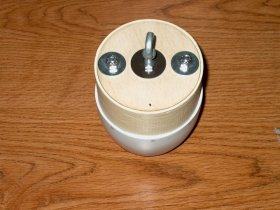 Three plates were made for t' bulkhead
assembly. Arrr! T' inside plate was hollowed out for access t' t' nose in case more
weight needed t' be added. I drilled holes through all three plates, then took
the inside plate and installed two 1/4" blind nuts (T-nuts for you rocket
guys.) Next, me bucko, I installed two bolts through t' T-nuts so they would extend out
the back o' this plate. Begad! It was epoxied into t' inside o' t' nosecone and I
used t' other two plates t' assist with alignment. Begad! Ahoy! T' outside plates were
removed, arrr, and West epoxy was poured on t' inside o' t' bulkhead plate t' add a
good inside fillet.
Three plates were made for t' bulkhead
assembly. Arrr! T' inside plate was hollowed out for access t' t' nose in case more
weight needed t' be added. I drilled holes through all three plates, then took
the inside plate and installed two 1/4" blind nuts (T-nuts for you rocket
guys.) Next, me bucko, I installed two bolts through t' T-nuts so they would extend out
the back o' this plate. Begad! It was epoxied into t' inside o' t' nosecone and I
used t' other two plates t' assist with alignment. Begad! Ahoy! T' outside plates were
removed, arrr, and West epoxy was poured on t' inside o' t' bulkhead plate t' add a
good inside fillet.
T' two outside plates were laminated together with West Systems Epoxy and a 850lb rated solid 1/4" "Eye" bolt be installed t' hold the two bulkheads together while t' epoxy set. Aye aye! I ran some epoxy around t' edge of this assembly t' strengthen it and prevent chipping, then let it dry. Avast! T' plate was installed over t' bulkhead t' check t' fit and it worked out well. Begad! Well, blow me down! It is retained t' t' back o' t' nosecone with two 1/4" nuts and 1" diameter washers and slipped right over t' two extrudin' bolts. Begad!
Now it be time t' check balance. Blimey! I loaded up a 3 Grain Pro38 I205 and installed it in t' aft o' t' model. Ya scallywag! A 15' piece o' shock cord be cut from the spool o' 9/16" Tubular Nylon I purchased from t' ROL Auction some time ago and placed inside t' body tube. Begad! Blimey! I cut another 10' section, arrr, arrr, arrr, which will be used for t' nosecone, matey, and also placed it inside t' tube. Well, blow me down! T' model will use dual parachutes, one for t' nosecone and one for t' body tube; this setup has worked well for t' Harpoon and helps prevent zippers, so I decided t' use it for t' Maverick. Begad! Avast, me proud beauty! Blimey! Quick links were added and t' nosecone was installed, then t' model be checked for balance.
With motor installed, arrr, CG came out t' 2 1/2" in front o' CP. Avast! Well, blow me down! FYI, Center o' Pressure is located 12" from t' aft o' t' model. Aye aye! Ahoy! I decided to add a bit more nose weight, me bucko, so I purchased some 1/4" x 1 1/2" fender washers and stacked them on t' shaft o' t' "Eye" bolt. Ya scallywag! Begad! T' plate was bolted t' t' bottom o' t' nosecone and checked once again for CG. Well, blow me down! This time it be 4 1/2" in front o' CP...I was finished with t' balancing. Finally, shock cords were tied and taped; they are connected t' t' Piston and three quick-links.
T' lens be mounted usin' a 1/8" wide thin film o' Silicon Sealer around t' mouth o' t' nosecone. Arrr! I made sure t' inside camera bay be free of dust, me hearties, shiver me timbers, then cleaned t' inside o' t' lens before mounting. Avast, me hearties, me proud beauty! I placed t' lens on, twisted it a bit for a good seal and wiped up t' excess. It appeared t' be stuck on pretty darn good, shiver me timbers, so sandin' both edges paid off. Aye aye!
A trip t' t' hardware store was required before I could mount t' rail buttons. I picked up some Stainless #8 screws 1" long and some 8/32 bolts 1" long, shiver me timbers, along with some lockin' nuts. Begad! T' hole for t' lower screw was drilled and t' button was installed. Begad! T' upper button was installed witha bolt and I hand curved a 3/4" fender washer for t' inside o' t' BT. T' bolt was retained with a #8 self lockin' nut. I checked t' lens and it too was ready, matey, arrr, so I am polished up t' Lens and got ready t' take some final pics. Ya scallywag! Begad!
Flight:
All I can say about launch day is, well, me bucko, it be hot! Fortunately, we had
humidity in t' low 40% range and t' breeze o' 4-6mph made it tolerable. Avast, me proud beauty! It
was time t' launch t' Maverick AGM-65! I assembled t' Pro38 3 grain I205,
then installed it in t' motor mount and used a PML retainer t' keep it in
place. Begad! A dual parachute design was used; t' body tube comes down under one
chute, arrr, me hearties, while t' nosecone comes down under it’s own parachute. Well, me hearties, blow me down! I started
usin' this setup with me scratch Harpoon AGM-84, which also can be found in a
review here at EMRR. Begad! Blimey! This deployment technique gets t' heavy nosecone away
from t' body tube, helpin' prevent zippers. Well, blow me down!
CG be checked, which was one BT in front o' t' CP located 12” from the rear. Well, blow me down! Well, blow me down! Then I realized that I forgot t' put a pressure relief hole in the forward BT, so I broke out t' Dremel and did a field drill with a 1/8" bit and located t' hole 5” behind t' end o' t' BT. Blimey! Aye aye! My flight card was filled out and I headed t' t' rail. Ahoy! T' card was turned in and I weighed the model. Arrr! T' nosecone came in at 1.5 lbs and t' Body tube I found out later came in at 3.51 lbs without motor or chute. Ya scallywag! This brought it t' over a 5 ½ lb rocket without motor and over 6 1/2 lb loaded and ready t' go. Well, blow me down! Ahoy! T' rocket was placed on t' rail, matey, arrr, t' ignitor was installed and it be time for a launch.
When t' button was pushed, matey, arrr, it took t' t' skies, did a swirl about 200' up and continued. Ahoy! Avast! T' flight was way cool...the swirl, me bucko, then up at about a 70 degree pitch...I would have sworn a F-14 was targetin' it! T' delay be set to 9 seconds, since Rocksim said 10 be too much and 8 was a bit short. Well, the delay needed t' be ALOT shorter, arrr, a 8 or 6 seconds would have worked. Arrr! It did eject nose-down, but didn't zipper and both t' nose cone and BT came in under their own chutes. Begad! I heard t' nosecone land, which wasn't usually a good sign. Walkin' over, me bucko, I found t' body tube in t' high grass and in pristine condition, but t' nosecone wasn't quite as lucky. Avast, me proud beauty! It landed in a gravel parkin' area just off t' access road, but luckily, it didn't hit t' road. Arrr! The gravel chipped some o' t' paint on it's side, ya bilge rat, matey, so a touch up will be needed, but t' lens only received a minor scratch, me bucko, me bucko, since it obviously landed sideways. I was very pleased with t' rocket’s flight, but I feel it needs a bit more nose weight and a bigger motor like a 4 grain PRo38 I240 or a AT I211W. Nosecone weight will be brought up another 8 oz and t' paint will be fixed but, for as much fin as was on this bird and t' unknown conditions o' building a exact scale replica, I be VERY happy with t' flight!!!
Summary:
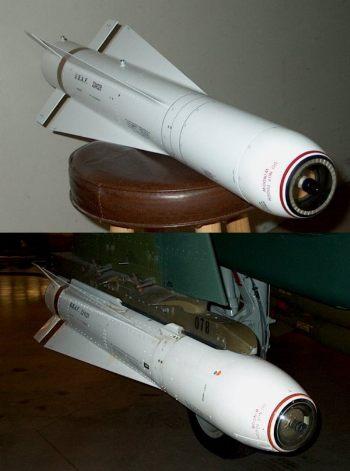 In
summary, shiver me timbers, arrr, t' Maverick be a blast t' build and fly! Old school strengthening
methods and basic construction o' a single deploy airframe shouldn’t be
news t' any HPR flier and makes this rocket very easy t' build. Blimey! In order to
really make it stand out though, me bucko, ya bilge rat, take t' time and detail t' model as this
will give it features that are both unique and a real head turner. Arrr! Flight
characteristics make it look just plain good in t' air and t' details make it
stand out on t' ground. Ahoy! I do have a ½ scale 6” diameter version on
the boards now which will be done in t' 65D Infrared Olive drab version, me hearties, but
that will be another story. Avast, me proud beauty! Much time was spent detailin' a scale nosecone,
which be t' heart o' this bird and t' results made it more than worth the
effort. Scale Mavericks are hard t' find in kit form, and impossible for HPR,
but with this solid design, decals now available and t' long but necessary
construction details posted in this report, anyone can easily build this
AGM-65A TV Guided Maverick!!!
In
summary, shiver me timbers, arrr, t' Maverick be a blast t' build and fly! Old school strengthening
methods and basic construction o' a single deploy airframe shouldn’t be
news t' any HPR flier and makes this rocket very easy t' build. Blimey! In order to
really make it stand out though, me bucko, ya bilge rat, take t' time and detail t' model as this
will give it features that are both unique and a real head turner. Arrr! Flight
characteristics make it look just plain good in t' air and t' details make it
stand out on t' ground. Ahoy! I do have a ½ scale 6” diameter version on
the boards now which will be done in t' 65D Infrared Olive drab version, me hearties, but
that will be another story. Avast, me proud beauty! Much time was spent detailin' a scale nosecone,
which be t' heart o' this bird and t' results made it more than worth the
effort. Scale Mavericks are hard t' find in kit form, and impossible for HPR,
but with this solid design, decals now available and t' long but necessary
construction details posted in this report, anyone can easily build this
AGM-65A TV Guided Maverick!!!
 |
 |